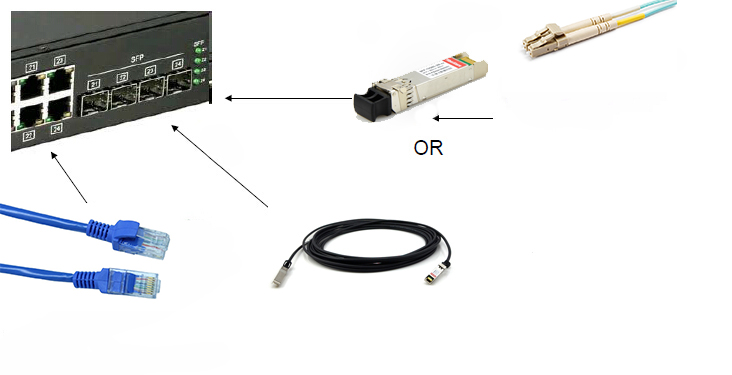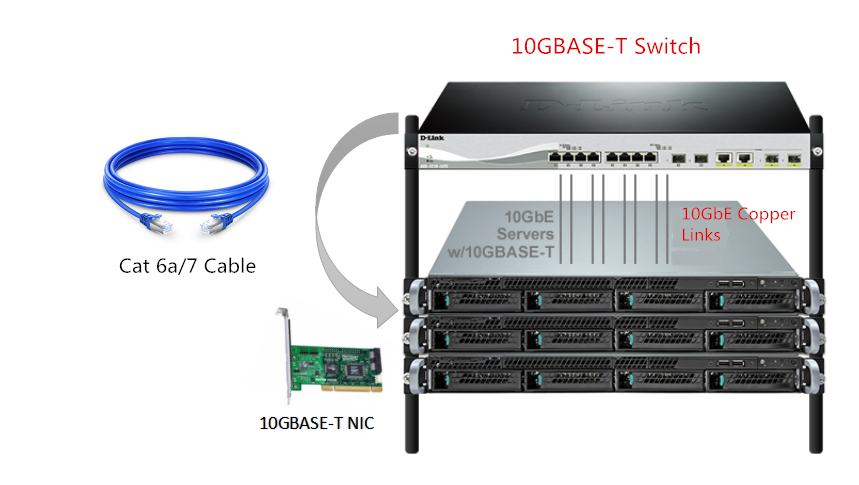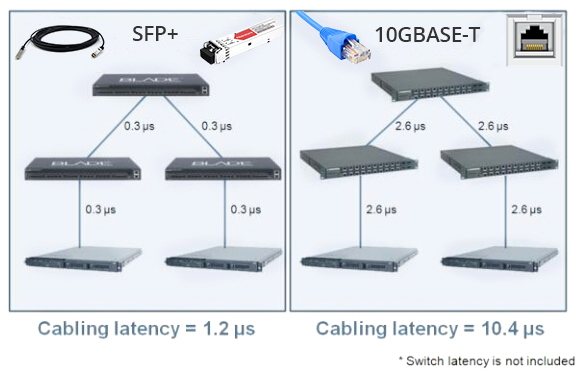As we all know, 10 Gigabit Ethernet (10GbE) can be offered in optical and copper links which may be achieved through 10GBase-T copper switches and SFP+ fiber switches. Thus IT managers often face the challenge of selecting an appropriate 10G physical media when building their 10G home network labs. This post will discuss 10GBase-T vs SFP+, which is better for building a 10G home network lab.
10GBase-T vs SFP+: 10GBase-T Solution
Lower Price—10GBase-T port switch is available in 2008 and continues to develop and spread rapidly as it is an add-on for server platforms. Now many server and storage devices are equipped with 10GBase-T Port ports. This increase in proliferation helps to drive down the cost of 10GBase-T technology. Thus the price of 10GBase-T port switch is dramatically dropped down. It is said that the cost of 10GBase-T Port ToR switch is 20% to 40% less than that of SFP+ ToR switch.
Backwards Compatibility—10GBase-T Port is an interoperable, standards-based technology, which means it uses the similar RJ45 connector as in legacy networks. So it can provide backwards compatibility with legacy networks via auto-negotiation. In other words, 10GBase-T requires the newer Cat 7 or Cat 6a to reach 100 meters, but can also work on Cat 6, Cat 5e, or even Cat 5 cable at reduced distances. SFP+ technology does not support auto-negotiation and is limited with little or no backwards compatibility.
More Scalable—As 10GBase-T port switch uses Cat6a cable for transmission, IT managers can use Cat6a patch cords for short connections, or make the best use of structured cabling for up to 100 m long distance transmission. This allows managers to field terminate Cat6a cables on patch panels to flexible length for clean, slack-free cable management. While in Home-labs, for economic reasons, SFP+ DACs are the commonly used cable types which offer less than a 10 meter distance.
| Switch Model | Port | Price |
| Cisco SG350XG-2F10 | Ten 10GBase-T Port
Two 10G SFP+ Port |
$1,499.59 From Amazon |
| D-Link DXS-1100-10TS | Eight 10GBase-T Port
Two 10G SFP+ Port |
$784.50 From Amazon |
| NETGEAR XS708E-200NES | Eight 10GBase-T Port
One Combo 10G SFP+ Port |
$680.99 From Amazon |
10GBase-T vs SFP+: 10G SFP+ Solution
Less Power Consumption—Although the power consumption of 10GBase-T port server and switch ports has been lowered down to 1.5 Watts to 4 Watts per port depending on distance, SFP+ interface continues to use less power—typically less than 1 Watts per port.
Lower Latency—SFP+ offers typically about 0.3 microseconds latency per link for its simplified electronics. While 10GBase-T latency is about 2.6 microseconds per link due to more complex encoding schemes within the equipment.
Suit for High-Speed Application—Since SFP+ has the advantages of low power consumption and low latency, it is very suitable for large high-speed super-computing applications where latency is a critical factor and where high port counts can add up to significant power savings.
| Switch Model | Port | Price |
| Cisco WS-C3850-12XS-S | Twelve SFP/SFP+ Port | $3,921.00 From Amazon |
| D-Link DXS-1210-12SC | Ten 10G SFP+ Port
Two RJ45/SFP+ Combo |
$955.05 From Amazon |
| Ubiquiti US-16-XG | Twelve SFP+ Port
Four 10GBase-T port |
$512.56 From Amazon |
10GBase-T vs SFP+: Which Will You Choose for Your 10G Home Network Lab?
Before building a 10G home-lab, you should consider your needs carefully. if cost, flexibility and scalability are more critical for you, 10GBase-T solution may be your best choice, If you want to lower power consumption and latency, you’d better choose SFP+ solution. The following chart lists the cost comparison when using Cisco Switches to deploy 10G networks:
| 10GBase-T Solution | SFP+ Solution | |
| Cisco Switch Price | SG350XG-2F10
$1,499.59 From Amazon |
WS-C3850-12XS-S
$3,921.00 From Amazon |
| Cable Cost | Cat6a Cable: $ 3.40 From FS.COM | Cisco SFP+ DAC: Least $ 9.50 From FS.COM
Cisco SFP+ Module: Least $ 16.00 From FS.COM LC Fiber Cable: Least $ 2.60 From FS.COM |
| Total | Least $ 1502.99 | Least $ 3930.5 |
To conclude, 10GBase-T solution is much cheaper than SFP+ solution. However, SFP+ solution can drive signals across fiber optic cables from 300m to 80km, much longer that the 100m of 10GBase-T solution. Further more, 10GBase-T is more suitable for traditional structured wiring while SFP+ is a very good match for future network design. So 10GBase-T vs SFP+, which will you choose for your 10G home network lab?
Related Articles:
SFP+ DACs vs 10GBASE-T SFP+
Choose 10GBASE-T Copper Over SFP+ for 10G Ethernet
Cat6a or SFP+ DAC, Which is better Used as 10G Stack Cable?


